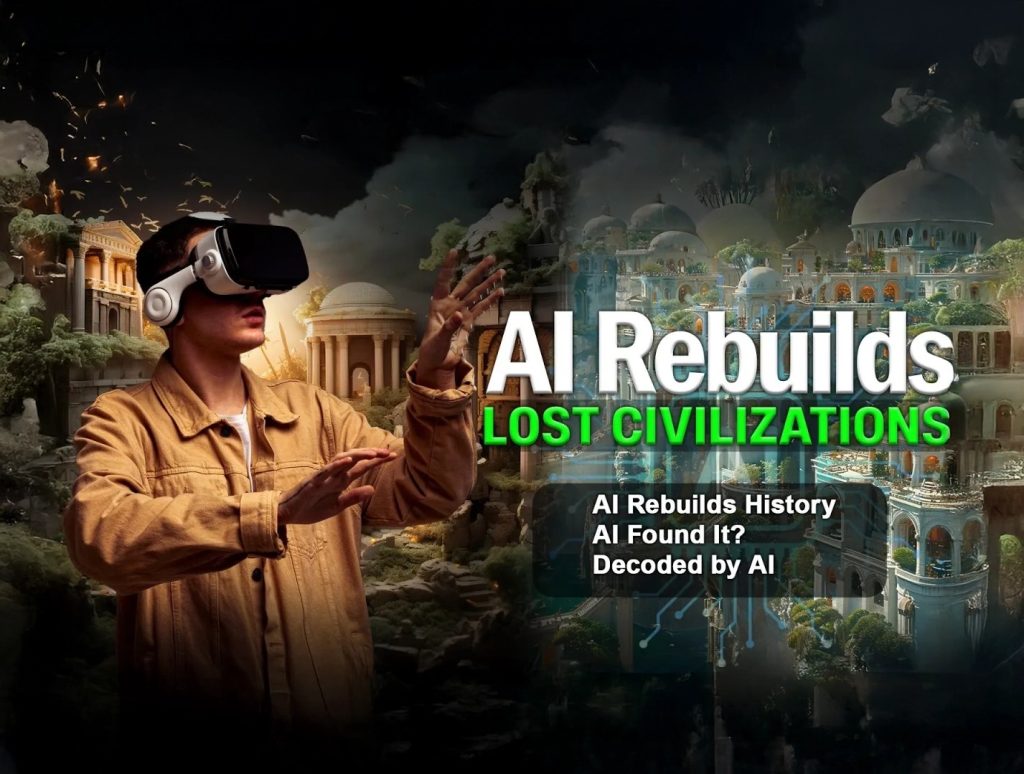AI Time Travel: Can Artificial Intelligence Reconstruct Lost Civilizations?
What if artificial intelligence could uncover the secrets of Atlantis? What if it could rebuild temples buried for thousands of years—or translate a language no human has spoken in 5,000 years?
Today, we explore how AI is becoming a digital time machine, bringing lost civilizations back to life.
AI Meets Archaeology
When most people think of AI, they imagine self-driving cars or chatbots. But behind the scenes, archaeologists are harnessing AI to resurrect the past. From reconstructing broken texts to predicting how ancient cities looked, artificial intelligence is helping humanity time travel—without a time machine.
Why It Matters
For the first time in history, we can explore ancient worlds not just through books, but through immersive experiences.
Imagine walking through ancient Babylon, standing in the Library of Alexandria, or seeing Machu Picchu as it once stood—rebuilt by algorithms and imagination.
AI isn’t just preserving history.
It’s reanimating it.
Example 1: The Dead Sea Scrolls
The Dead Sea Scrolls, fragile fragments written over two millennia ago, have puzzled historians for decades. Many were too damaged or incomplete to decipher.
Today, AI models are filling in the missing words, predicting the handwriting of ancient scribes, and reviving texts once thought lost forever.
In 2021, researchers used machine learning to identify different scribes who contributed to the scrolls, by analyzing handwriting patterns invisible to the human eye (Popović et al.). It’s as if history itself is speaking again.
Example 2: The Hidden Amazon Ruins
Beneath the endless green of the Amazon rainforest, satellites once saw only trees. But AI changed that.
By scanning satellite data, AI now reveals geometric structures, grids, and roads—possible remains of vast, unknown civilizations.
In 2022, scientists used LiDAR imaging combined with AI to detect complex urban layouts hidden beneath jungle canopy—suggesting sophisticated pre-Columbian societies (Heckenberger and Walker).
Could we be standing atop the forgotten heart of a lost civilization?
Example 3: Pompeii Reconstructed
The streets of Pompeii lie frozen in ruin—a city silenced by volcanic ash since 79 CE. But through AI-driven 3D reconstruction, researchers are digitally rebuilding the city, restoring murals, and even recreating ambient sounds of ancient marketplaces.
Projects like Pompeii Commitment and RePAIR use neural networks to piece together fresco fragments and virtually restore entire rooms (Sutherland). Through AI’s lens, Pompeii breathes again—its people, homes, and art reborn in pixels and light.

The Future: AI’s Digital Time Machine
So, what’s next?
AI could help decode languages we’ve never cracked—like the Indus Valley script, which has defied linguists for a century. Algorithms are being trained to detect recurring symbol patterns that may unlock its meaning (Rao et al.).
It might even recreate lost wonders, from the Hanging Gardens of Babylon to the mythical city of Atlantis, offering scientists visual and spatial models of what these civilizations might have looked like.
Conclusion: From Myths to Models
If AI could resurrect one lost civilization, which would you explore first—Atlantis, the Aztecs, or Ancient Egypt at its peak?
Drop your answer in the comments. And if this journey through time amazed you, share it with a history-loving friend.
For further assistance, visit our channel and refer the video
AI Time Travel: Can Artificial Intelligence Reconstruct Lost Civilizations?

Share This :
References
- Heckenberger, Michael, and Walker, John. “Pre-Columbian Urbanism in the Amazon: A Networked Landscape.” Proceedings of the National Academy of Sciences, vol. 119, no. 8, 2022, pp. 1–8.
- Popović, Mladen, Maruf Dhali, and Lambert Schomaker. “Artificial Intelligence and the Dead Sea Scrolls: Identifying Ancient Scribes Using Machine Learning.” PLOS ONE, vol. 16, no. 4, 2021, pp. 1–15.
- Rao, Rajesh P. N., et al. “Entropic Evidence for Linguistic Structure in the Indus Script.” Science, vol. 324, no. 5931, 2009, pp. 1165–1166.
- Sutherland, Luke. “Digital Archaeology: AI Reconstruction Projects Bring Pompeii Back to Life.” Smithsonian Magazine, 2023.
- UNESCO. “AI and Cultural Heritage: Reconstructing the Past for the Future.” UNESCO Digital Heritage Report, 2022.


